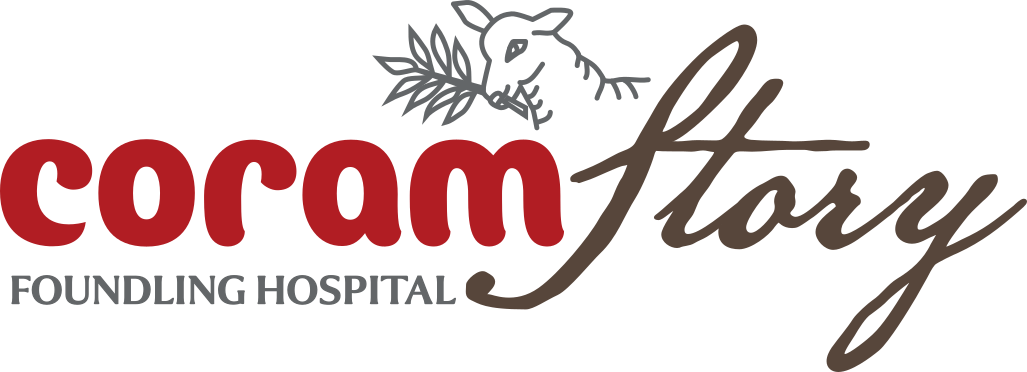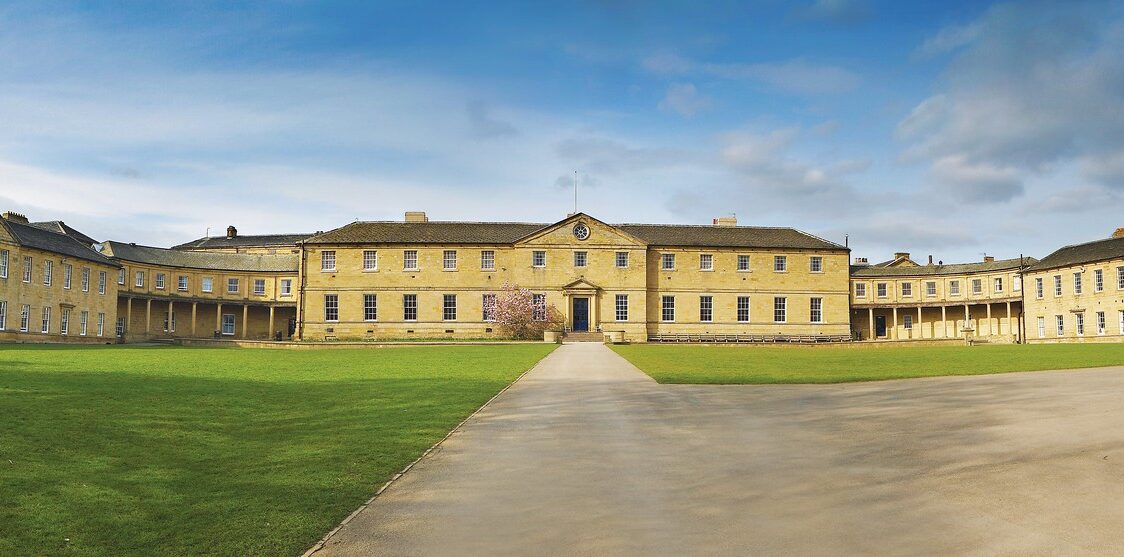During the General Reception period, 1756-1760, the Foundling Hospital received overwhelming numbers of infants, and was required by its Parliamentary grant to accept them all. This led to the establishment of branch hospitals in the English regions, of which the Ackworth hospital in Yorkshire was the largest, the first to open, and the last to close.
Setting up the Ackworth branch
In 1757, the Foundling Hospital in London purchased Seaton’s farm with 58 acres of land in Ackworth, Yorkshire, and recruited local landowners as the Board of Governors. Sir Rowland Winn of Nostell Priory, who owned about half of Ackworth village, was a leading board member. Much of the day-to-day administration fell to the Reverend Timothy Lee, rector of Ackworth, and to the steward, John Hargreaves, and his wife, who was the matron of the branch hospital.
Seaton’s farmhouse was replaced with a new purpose-built hospital for 500 children. Revd. Lee drafted a plan for a central building with two wings, the first of which opened in 1757. As the buildings were completed, children were moved into them from London and the surrounding area. The first children from London arrived in August 1757, and in May 1758, children who had been placed with local nurses as infants began to enter as five-year-olds. Later, children were also sent from the other branch hospitals, like Mary Dobber (No. 6977). Lee and Hargreaves designed a ‘caravan’ to allow parties of nurses to go and collect the children.
Education and health
In total, 2,665 children were received at the Ackworth hospital. Most were about five years old and spent 3-5 years there before being apprenticed. Older children sent from other branch hospitals spent 1-3 years at Ackworth.
The Foundlings’ education included reading and work-related skills. For boys, these were in gardening and husbandry (caring for livestock). Girls learned to sew, knit, and weave woollen textiles on the hospital’s handloom. They produced finished flannel fabric which was sold to the London Hospital and was expected to be of commercial quality.
As the first branch hospital to open, Ackworth was viewed as a healthier location than London and originally received children with chronic health problems and disabilities. Some of these, like Mary Elson (No. 1002) and Theodore Barrow (No. 15514), stayed at Ackworth until it closed. Gradually, though, as the largest of the hospitals, Ackworth received the largest share of the children who had been admitted during the General Reception period.
The children were well fed, and outdoor exercise was a part of their day, but they still contracted illnesses, notably measles, whooping cough, smallpox, and consumption. The parish records for St Cuthbert, Ackworth include the burials of 19 Foundlings in early 1762, indicating outbreaks of infectious diseases. Although the children were inoculated against smallpox, in 1765, 18 children died from it. Consumption caused 34 deaths of children while at Ackworth and several more among young apprentices, who would likely have caught the latent disease while at the hospital.
Apprenticeships
In total, 2,366 children were apprenticed from Ackworth. Most were apprenticed until age 21, with some until age 24. As the other branch hospitals began to close in the late 1760s, the large numbers of older children arriving at Ackworth, aged 8-11, were found apprenticeships within a year and even within a few weeks.
The boys’ trades were diverse and reflected the local industries. Many boys were apprenticed to farmers to work with livestock or as agricultural labours, such as George Diston (No. 4935). Others learned trades associated with boat building (nail-making, stay-making, rope-making). Some were apprenticed to metal industries (cutlers, filesmiths, scissorsmiths) and blacksmithing, such as Edmund Fitz-George (No. 8059). The majority of the girls entered domestic service, like Ann Young (No. 954) and Ann Fordyce (No. 5537), but some were apprenticed to textile trades.
Several children were apprenticed to their nurse’s husbands as five- and six-year olds. Although it was not uncommon for children to work at this young age, these seem to indicate informal adoptions because the nurse’s family had formed a strong attachment to the Foundling in their care.
Sometimes the Ackworth branch allowed groups of apprenticeships to a single employer. Sir Rowland Winn took five apprentices as husbandmen, presumably on his Nostell estate. Sir James Lowther had 31 apprentices. Six children were apprenticed to Revd. Lee in varied domestic service, including husbandry and gardening.
In a terrible case, Martin Browne, a Leeds cloth dealer was assigned 74 girls between 1761 and 1765 with the intention of using the weaving skills they had learned at Ackworth. This was before mechanisation, and the girls, of around eight years old, were to produce worsted pieces similar to those woven by adult men. The girls’ health collapsed due to the demanding work in poor conditions, and 50 died. Some of their burials at Horsforth Chapel in 1767 were annotated as ‘one of Mr Browne’s foundlings’.
In two other cases, masters were tried for murder. John Bolton, a farmer, was convicted of the murder of Elizabeth Rainbow (No. 4104). He committed suicide at York Castle while awaiting execution. A court granted Jemima Dixon (No. 9264) legal release from her apprenticeship with William Butterworth because of his cruelty, but it came too late.
We know that several boys established their own businesses in their apprentice trade because they appear as adults in the records of Freemen of the City of York. These include Thomas Brassey, tailor (No. 12605); James Underwood, comb-maker (No. 3241); Marmaduke Weaver, grocer (No. 2997); and Arthur Tucker, barber (No. 9821). Aaron Price (No. 5157) had been an apprentice bookbinder but went on to trade as a fruiterer, while John Glover (No. 8534) was a publican.
The 1789 Poll Book for Beverley lists among the town’s electors Ackworth alumni who had been apprenticed locally. These were William Bohun, carrier (No. 8622); David Calder, tallow-chandler (No. 8721); George Colchester, blacksmith (No. 14702); and Thomas Coxton, waiter (No. 5345). Some of these appear in Poll Books as late as 1807.
Alexander Banks (No. 4690) served his apprenticeship as a roper at South Kirkby and married in 1778. When two justices of the peace questioned his right of settlement, his affidavit explained that he had been apprenticed from the Ackworth branch for nine years, and this seems to have been accepted. Alexander’s youngest son, George, was a Sergeant in the 3rd Battalion, Royal Regiment of Artillery, and served at Waterloo.
The most successful girl seems to be Blanch Waxby (No. 6060), who twice married farmers at St Michael le Belfrey, York and is mentioned in a sizable land transaction valued at £150 (about five times a servant’s annual wage at the time). The parish records at Brayton have the note ‘From the Hospital’ on baptisms of the children of two Foundlings, Henry Carew (No. 7630) and Ursula Batts (No. 7789), who married at Wheldrake in 1784.
Closure of the branch
In late 1773, the Ackworth branch was closed. Most children had been found apprenticeships, and those remaining were sent to London. The Founding Hospital tried to find a buyer for the estate, but it was not sold until seven years later, when the Society of Friends bought it for £7,000. The building has operated as a Quaker denomination school ever since.



